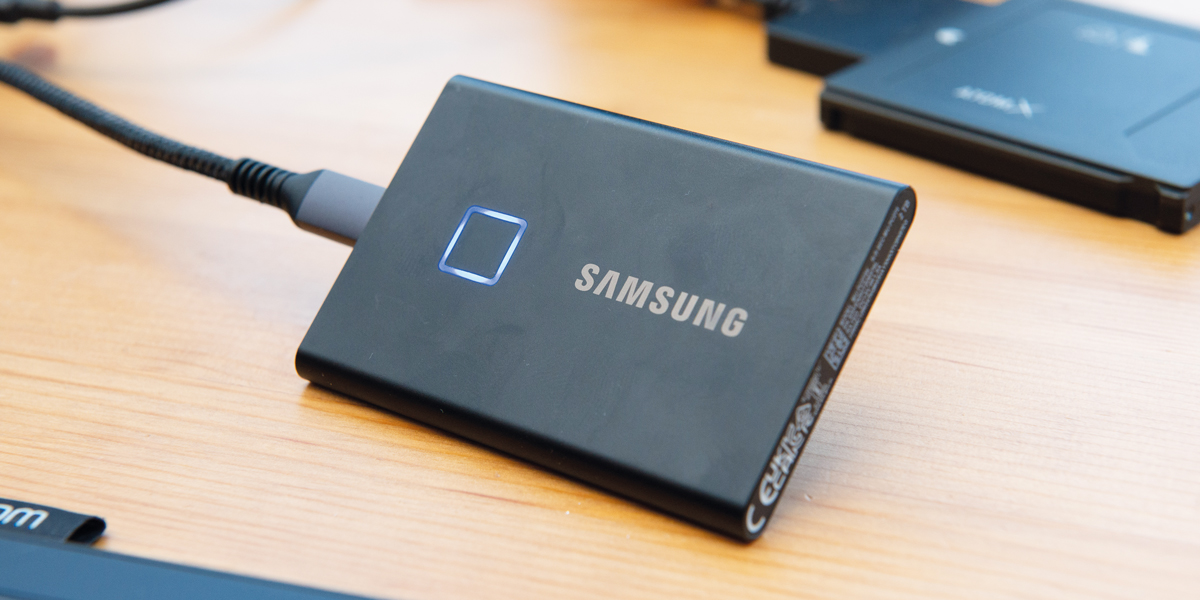
SSD T7 Touch: Central to your workflow
Posted on May 18, 2023 by Samara Husbands
Professional filmmaker Martyn Moore reveals why he always has the Samsung Portable SSD T7 Touch to hand
Advertisement feature
The Samsung Portable SSD T7 Touch is my constant companion. Most of my work is conference filming, often done overseas. My cameras and laptop travel to the event in a dedicated flight case, courtesy of the UK-based production company that provides staging for the conference organisers.
But the conference prep starts weeks before, and I usually make an opening ‘wow’ video to wake up the audience and get them excited for the days ahead. I’ve already shared this video with the production team before I go, but a copy of it always goes to the event on my Samsung Portable SSD T7 Touch.
Also on the 2TB SSD, which is in my pocket as I fly to make sure it doesn’t get lost by baggage handlers, is a collection of sound files and graphics that I think may come in handy – my mobile assets library.
Safety at speed
My main camera uses 128GB SD cards for storage, while my second writes to an external recorder. At the end of each shooting session, I copy footage to my laptop and the portable drive, giving me two copies of everything. A USB Type C connection enables blistering 1050MB/s read and 1000MB/s write speeds.
The blue square shows a pulsating light while the data transfers, which means I can still tell if it’s working from a distance away or have other windows open on the laptop screen. The AV production team records all the stage activity on a fixed camera and, at the end of each morning and afternoon session, I ask them to copy the clips from this over to my Samsung Portable SSD T7 Touch. The technical operative says it’s the fastest he’s used. The stage clips stay on the drive, but I also copy them to my laptop – again for safety.
Since I have to let members of the team access the drive on location, I don’t need the extra security of the built-in fingerprint scanner with AES 256-bit encryption for those situations. But when I am travelling, I enable this to keep all my data safe. It’s easy to work and simple to turn on and off.
Conference filming involves a lot of on-location post-production, outputting three or four short sequences every day and passing them to the social media team to post online. I plug my portable drive into their laptops to do this. At the end of each day, I create a 30-second highlight sequence to be shown on the big screen as the main hall fills up next morning. This is given to the AV team on the portable drive. Social media sequences are also backed up to the Samsung Portable SSD T7 Touch, where I know they’ll be safe.
“The blue square shows a pulsating light while the data transfers, which means I can still tell it’s working from a distance”
Synchronised
At the end of the conference, when all the staging, lighting and sound equipment has been torn down, the time-lapse camera at the back of the room is turned off. This has been taking a photo every 20 seconds for the duration of the event and saves them as fairly big AVI files. These are written to my portable drive by the AV company and I copy them to my laptop, too.
Before packing up my mobile post-production suite, I copy all project files to the Samsung Portable SSD T7 Touch before putting all my gear, laptop included, back into the flight case to be shipped back to the UK with the AV and staging equipment.
The only bit of kit that flies back with me is my portable drive, sitting next to my phone (also a Samsung) and passport. It’s comforting to know that should I never see my cameras or laptop ever again, my work over the last three or four days is safe and sound in my pocket.
My choice of Samsung phone and tablet is no accident. USB Type C connectors on these devices allow me to transfer data between them and the portable drive. My Samsung smartphone can act as a perfect media player and monitor for video files. The Samsung Portable SSD T7 Touch is at the centre of my workflow, and it’s a long-term relationship that continues to serve me well.
More information go to the Samsung website.
Originally published in the May/June issue of Pro Moviemaker.










